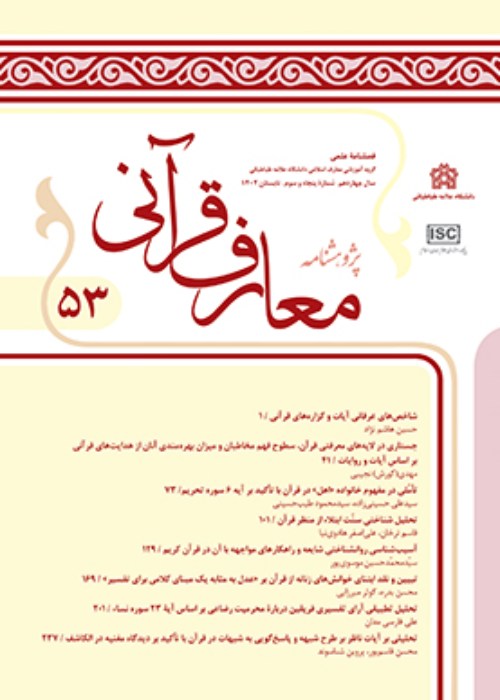Historical Course and Deficiencies of Comparative Interpretation from the 4th to the 6th Century A.H.
Author(s):
Article Type:
Research/Original Article (ترویجی)
Abstract:
Comparative studies are the blessed events in the contemporary period that put humanities at the departure point for a dramatic progress. The various branches of religious studies, including the interpretation of the Quran, can be one of the manifestations of such studies. The particular religious thought of the Quran commentators has led to the production of different exegetical products, so that the effect of the two schools of Shia and Sunni on the interpretation of some verses - especially theological and jurisprudential verses- is undeniable. Applying a comparative approach in interpreting these two kinds of Quranic verses, while also giving rise to the transparency of the exegetical views of the Shia and Sunni commentators, will increase the knowledge of the interpretation and selection of stronger views by Quran exegetes. The present paper seeks to study the beginning of the comparative approach to the interpretation and evolution of it through the study of the most important inferential interpretations of the Fourth, the Fifth and Sixth Centuries. In this essay, some of the most controversial verses among jurisprudents and theologians of Shia and Sunni have been selected and the viewpoints of a commentator of a cult in comparison to another cult commentator have been evaluated. The authors of this paper seek to answer the question of what the characteristics are in the comparative approach in the relevant commentaries and what each commentator has looked at, and by what criteria, criticized these views. The results of this research show that with the simultaneously development of two knowledge of theology and jurisprudence in the Middle Centuries A.H, a comparative Shiite-Sunni approach has led to inferential interpretations, and in both schools there has been evolutionary development, and subsequent commentators have compensated for the weaknesses of previous interpreters. Examples that have been examined in this study include points that highlight the strengths and weaknesses of the comparative interpretation, which could be a light for commentators, and a good departure point for interpretive knowledge.
Keywords:
Language:
Persian
Published:
Journal of Qur'anic Knowledge, Volume:8 Issue: 30, 2017
Pages:
7 to 28
magiran.com/p1849052
دانلود و مطالعه متن این مقاله با یکی از روشهای زیر امکان پذیر است:
اشتراک شخصی
با عضویت و پرداخت آنلاین حق اشتراک یکساله به مبلغ 1,390,000ريال میتوانید 70 عنوان مطلب دانلود کنید!
اشتراک سازمانی
به کتابخانه دانشگاه یا محل کار خود پیشنهاد کنید تا اشتراک سازمانی این پایگاه را برای دسترسی نامحدود همه کاربران به متن مطالب تهیه نمایند!
توجه!
- حق عضویت دریافتی صرف حمایت از نشریات عضو و نگهداری، تکمیل و توسعه مگیران میشود.
- پرداخت حق اشتراک و دانلود مقالات اجازه بازنشر آن در سایر رسانههای چاپی و دیجیتال را به کاربر نمیدهد.
In order to view content subscription is required
Personal subscription
Subscribe magiran.com for 70 € euros via PayPal and download 70 articles during a year.
Organization subscription
Please contact us to subscribe your university or library for unlimited access!


